
Yes, traveling from Jammu to Srinagar by road is generally safe. Traveling from Jammu to Srinagar by road is an iconic journey that promises breathtaking views of the majestic Himalayas, lush green valleys, and an unparalleled sense of adventure. However, concerns about safety, road conditions, and the overall travel experience often worry potential travelers. This comprehensive guide covers all aspects of the journey, offering detailed insights and practical advice to ensure a safe and enjoyable trip.
1. The Route: An Overview
The road journey from Jammu to Srinagar spans approximately 300 kilometers along National Highway 44 (NH44). Typically, the journey takes about 8 to 10 hours under normal conditions, but this can vary depending on weather, traffic, and road conditions.
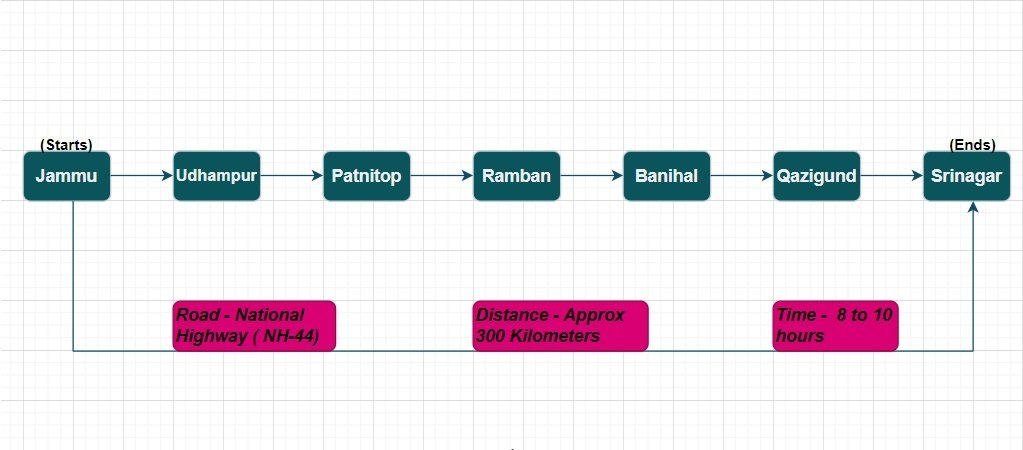
2. Understanding Road Conditions
1. Weather-Related Challenges
a) Winter (December to February):
- Snowfall and Road Blockages: During winter, heavy snowfall in the higher reaches, particularly around Patnitop and the Jawahar Tunnel, can lead to road blockages. It’s common for the highway to be closed temporarily during heavy snowstorms. Always check the weather forecast before planning your trip and be prepared for sudden weather changes.
b) Monsoon (July to September):
- Landslides and Flooding: The monsoon season brings heavy rains, which can trigger landslides, especially in the mountainous stretches. Landslides can cause road closures and significant delays. Flash flooding is another concern, particularly in lower-lying areas. Stay informed about weather conditions and road closures through reliable sources.
2. Road Infrastructure
a) Recent Improvements:
- Tunnels: The construction of the Chenani-Nashri Tunnel (Dr. Syama Prasad Mookerjee Tunnel) and the Banihal-Qazigund Tunnel has significantly improved travel conditions. These tunnels bypass some of the more treacherous mountain passes, reducing travel time and increasing safety.
- Widening and Paving: Ongoing efforts to widen and repave sections of NH44 have made the road safer and more navigable. However, construction activities can still cause temporary delays and diversions.
b) Ongoing Challenges:
- Rough Patches and Construction Zones: Despite improvements, some sections of the highway remain under construction or are in need of repair. These areas can be rough and challenging to navigate, particularly during adverse weather conditions.
- Traffic Congestion: Traffic jams are common, especially near towns and construction zones. Plan for extra travel time and remain patient.
3. Security Considerations
a) Political Stability
Historical Context:
- Past Unrest: The region of Jammu and Kashmir has a history of political unrest and conflict. While the situation has generally stabilized in recent years, sporadic incidents can still occur. It’s important to stay updated on the current political climate.
Current Situation:
- Improved Security: Increased security measures and a greater presence of law enforcement have improved safety along the highway. The government regularly monitors the situation, and travel advisories are issued as needed.
b) Checkpoints and Curfews
Security Checkpoints:
- Routine Checks: Expect to encounter several security checkpoints along the route. These are manned by the Indian Army and paramilitary forces. While these checkpoints may cause minor delays, they are in place to ensure the safety of travelers.
- Documentation: Carry valid identification and travel documents. Cooperate with security personnel and follow their instructions to ensure a smooth passage.
Curfews:
- Occasional Restrictions: Curfews and travel restrictions can be imposed in response to security threats or incidents. These are usually temporary and localized. Stay informed about any curfews through news updates and local sources.
4. Preparing for the Journey
1. Planning Ahead
a) Research and Updates:
- Travel Advisories: Regularly check travel advisories issued by the government or reliable travel websites. These advisories provide valuable information about current conditions and potential risks.
- The official website of the Jammu and Kashmir government is https://www.jk.gov.in/.
The official tourism website for Jammu and Kashmir is https://www.jktourism.org/. - Weather and Road Conditions: Stay updated on weather forecasts and road conditions through reliable sources such as the Indian Meteorological Department and local news outlets.
b) Accommodation:
- Booking in Advance: Secure your accommodation in advance, especially during peak travel seasons. Popular destinations along the route, such as Patnitop, offer various lodging options ranging from budget hotels to luxury resorts.
2. Choosing the Right Time to Travel
a) Daylight Travel:
- Better Visibility: Traveling during the day offers better visibility and reduces the risk of accidents. Additionally, security personnel are more likely to be present during daylight hours, enhancing safety.
- Avoiding Night Travel: Night travel is generally discouraged due to poor visibility, higher risks of accidents, and reduced availability of assistance in case of emergencies.
3. Reliable Transportation
a) Vehicle Choice:
- Four-Wheel Drive: Opt for a four-wheel-drive vehicle, which is better suited to handle rough patches and adverse weather conditions.
- Local Drivers: Consider hiring a local driver who is familiar with the terrain and road conditions. Local drivers are also better equipped to handle unexpected situations and navigate security checkpoints efficiently.
b) Vehicle Maintenance:
- Pre-Trip Check: Ensure your vehicle is in good condition before embarking on the journey. Check the tires, brakes, engine, and other critical components. Carry spare tires, tools, and essential spare parts.
- Emergency Kit: Pack an emergency kit that includes a first-aid kit, extra food and water, blankets, a flashlight, and a fire extinguisher. Mobile networks may be unreliable in some areas, so consider carrying a satellite phone or a portable GPS device.
4. Staying Connected
a) Communication:
- Informing Others: Keep family or friends informed about your travel plans, expected arrival times, and any changes to your itinerary. Regularly update them on your progress.
- Local Contacts: Have contact information for local authorities, your accommodation, and any emergency services you might need. Familiarize yourself with the locations of nearby hospitals and police stations.
5. Personal Safety
a) Safety Precautions:
- Travel Companions: If possible, travel with companions. There’s safety in numbers, and having someone with you can be invaluable in case of emergencies.
- Avoiding Strangers: Be cautious when interacting with strangers. While most people are friendly and helpful, it’s important to remain vigilant and avoid sharing personal information.
b) Health Precautions:
- Medical Supplies: Carry any necessary medications and a basic medical kit. Be prepared for altitude-related issues if you are not accustomed to high altitudes.
- Hydration and Nutrition: Stay hydrated and carry sufficient food supplies, especially if you have dietary restrictions or preferences.
6. Cultural Sensitivity
a) Respecting Local Customs:
- Cultural Awareness: Jammu and Kashmir have a rich cultural heritage. Show respect for local customs, traditions, and religious practices. Dress modestly and behave respectfully.
- Language: While Hindi and English are widely understood, learning a few basic phrases in Kashmiri or Dogri can be helpful and appreciated by locals.
5. Detailed Route and Key Stops.
1. Jammu to Udhampur
a) Distance: Approximately 65 kilometers
b) Travel Time: 1.5 to 2 hours
c) Key Highlights:

- Jhajjar Kotli: A scenic picnic spot along the way, known for its cool waters and lush surroundings.

- Nandini Wildlife Sanctuary: A great stop for wildlife enthusiasts, offering a chance to spot various species of birds and animals.
2. Udhampur to Patnitop
a) Distance: Approximately 45 kilometers
b) Travel Time: 1 to 1.5 hours
c) Key Highlights:
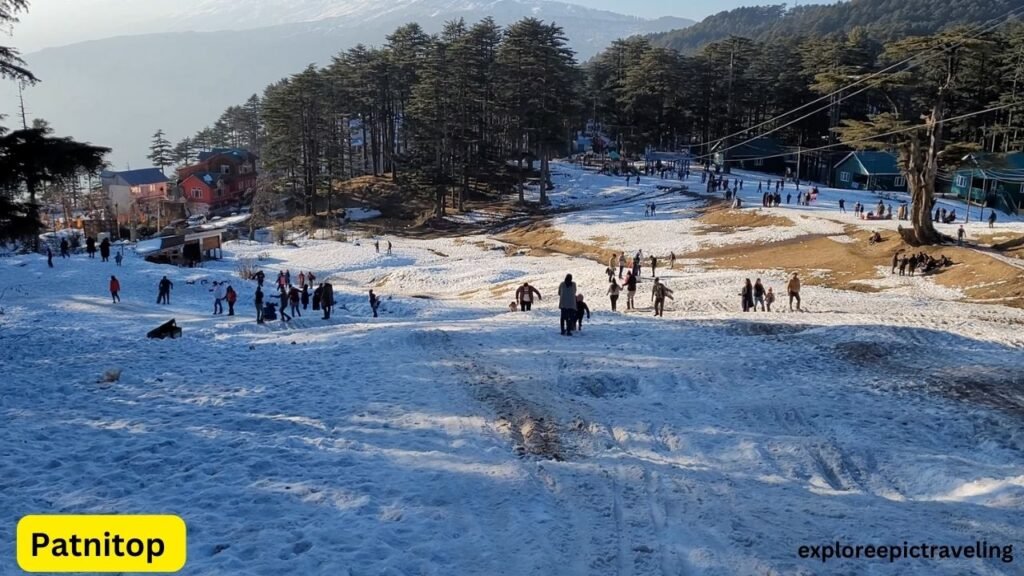
- Patnitop: A popular hill station, Patnitop offers stunning views, pleasant weather, and opportunities for trekking, paragliding, and other adventure activities. Don’t miss the serene Sanasar Lake and the ancient Naag Temple.
3. Patnitop to Ramban
a) Distance: Approximately 55 kilometers
b) Travel Time: 1.5 to 2 hours
c) Key Highlights:

- Nashri Tunnel: The Chenani-Nashri Tunnel, also known as the Patnitop Tunnel, is the longest road tunnel in India. It significantly reduces travel time and bypasses the steep and winding mountain roads.
- Ramban: A small town along the Chenab River, Ramban is a good place for a short break. The scenic views and local eateries make it a pleasant stop.
4. Ramban to Banihal
a) Distance: Approximately 40 kilometers
b) Travel Time: 1 to 1.5 hours
c) Key Highlights:
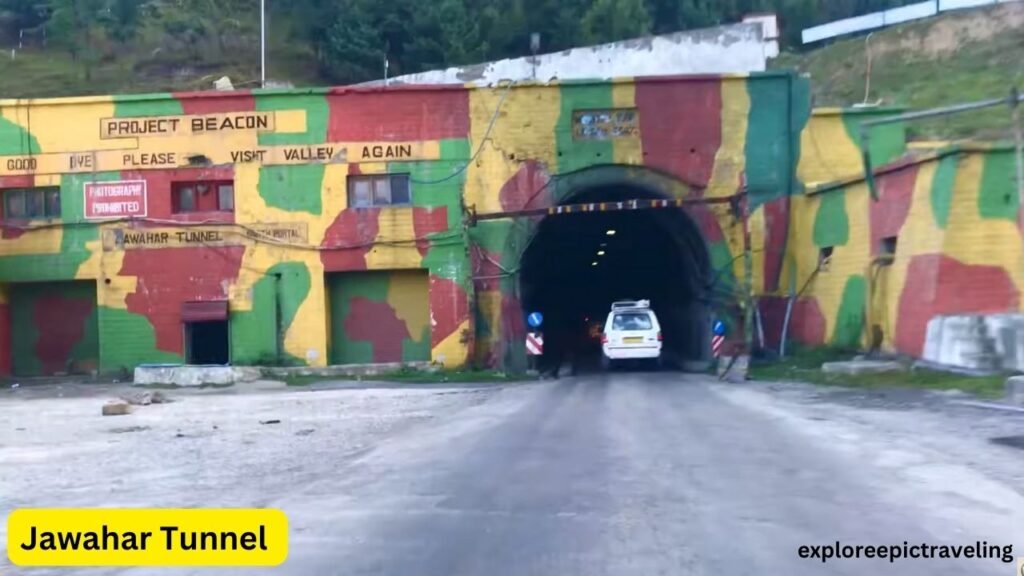
- Jawahar Tunnel: This tunnel, named after India’s first Prime Minister Jawaharlal Nehru, is a critical part of the highway. It connects the Kashmir Valley with the rest of India and is often covered in snow during winter.
- Banihal: A gateway to the Kashmir Valley, Banihal offers beautiful views and is known for its fresh mountain air. The town is also famous for its local crafts and markets.
5. Banihal to Qazigund
a) Distance: Approximately 30 kilometers
b) Travel Time: 45 minutes to 1 hour
c) Key Highlights:
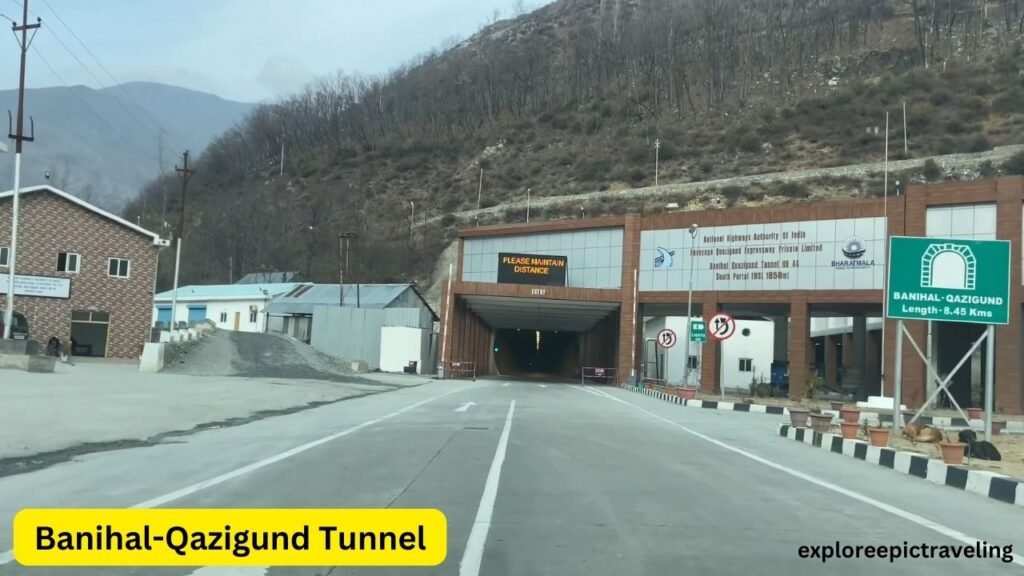
- Banihal-Qazigund Tunnel: Also known as the Pir Panjal Railway Tunnel, this is the longest railway tunnel in India and one of the longest in Asia. It bypasses the traditional Jawahar Tunnel and offers a faster and safer route.
- Qazigund: Known as the ‘Gateway of Kashmir,’ Qazigund is the first major town in the Kashmir Valley. It offers picturesque views and a chance to experience the local culture.
6. Qazigund to Srinagar
a) Distance: Approximately 75 kilometers
b) Travel Time: 2 to 2.5 hours
c) Key Highlights:
- Anantnag: A major town known for its beautiful gardens and springs. Martand Sun Temple, located nearby, is an ancient temple with historical significance.
- Saffron Fields of Pampore: As you approach Srinagar, you’ll pass through Pampore, known for its saffron fields. This is a great spot to buy authentic Kashmiri saffron.
- Dal Lake: Upon reaching Srinagar, a visit to the iconic Dal Lake is a must. Enjoy a shikara ride and explore the floating markets.
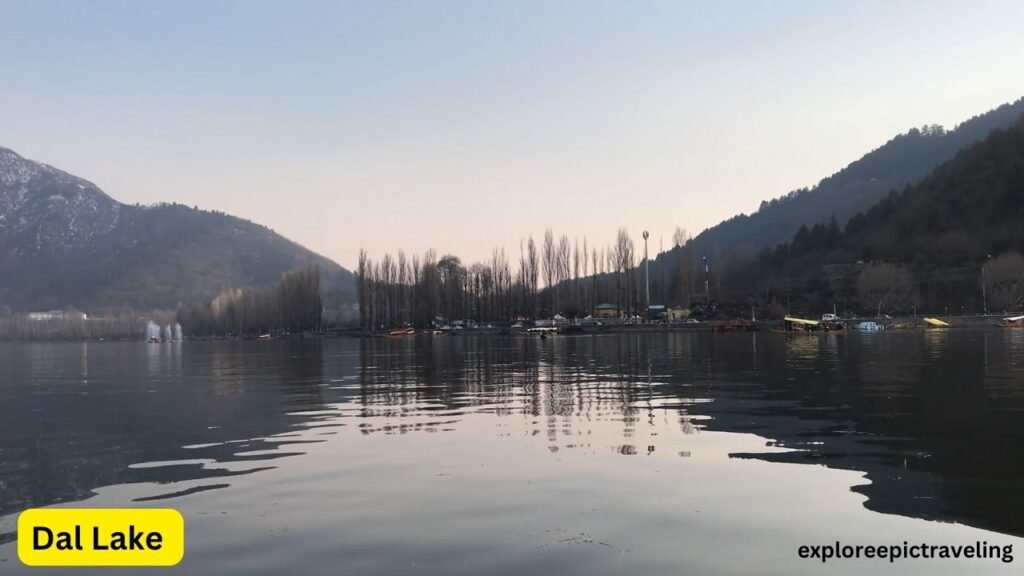
6. Safety and Emergency Contacts
a) Local Authorities:
- Police: Dial 100 for police assistance in case of emergencies.
- Ambulance: Dial 102 for ambulance services.
- Tourist Assistance: The Jammu and Kashmir Tourism Department can provide valuable assistance and information. Their helpline number is 1800 180 7152.
b) Emergency Supplies:
- First-Aid Kit: Include bandages, antiseptic wipes, pain relievers, and any prescription medications.
- Food and Water: Carry enough bottled water and non-perishable food items to last the journey.
- Communication Devices: Mobile phones, portable chargers, and a satellite phone if possible.
c) Local Contacts:
- Accommodation: Keep the contact information of your hotel or guesthouse handy.
- Local Guides: Hiring a local guide can enhance your experience and provide valuable insights into the region’s history and culture.
7. Conclusion
- Traveling from Jammu to Srinagar by road is a journey filled with natural beauty, cultural richness, and a sense of adventure. While there are challenges, particularly related to weather, road conditions, and security, meticulous planning and informed decision-making can ensure a safe and memorable trip. By staying updated on current conditions, choosing reliable transportation, and taking necessary precautions, you can enjoy the stunning landscapes and warm hospitality that this route has to offer. Embrace the journey, respect the local culture, and create lasting memories in one of India’s most enchanting regions.
8. FAQs.
Q1.Is it safe to travel from Jammu to Srinagar by road in December?
Ans. No, traveling from Jammu to Srinagar by road in December may not be safe due to potential snowfall and icy conditions. It’s essential to check weather forecasts and road conditions before starting your trip.
Q2.Is it safe to travel at night from Jammu to Srinagar?
Ans. Traveling at night from Jammu to Srinagar can be safe, but it’s important to consider factors like road conditions and weather. Additionally, it’s advisable to check for any travel advisories or security updates before starting your journey.
Q3.Is there any direct bus from Jammu to Srinagar?
Ans. Yes, there are 5 buses operating between Jammu and Srinagar. The first daily service is scheduled at 03:00 AM and the last one at 09:00 PM. Some of the most popular operators on this route are New Pal Travels, Jamna Travels-Jammu, PRAKASH TOURISM, North Kashmir Tour and Travels and SPEED BUS.
Ans. The cost of a bus ticket from Jammu to Srinagar can vary depending on factors such as the type of bus, the time of year, and any promotional offers or discounts. On average, a standard bus ticket for this route may range from approximately ₹500 to ₹1000 or more. It’s advisable to check with bus operators for specific pricing and any available deals.
Q5.Is there a train from Jammu to Srinagar?
Ans. No, there are no direct trains connecting Jammu and Srinagar. To reach Srinagar from Jammu, travelers can opt for a train to Udhampur, which takes about 2 hours, followed by a road journey to Srinagar.
Q6.How much fare is from Jammu to Srinagar by road?
Ans. The fare for traveling from Jammu to Srinagar by road can vary depending on the mode of transportation chosen, such as bus, taxi, or private car. On average, the fare for a bus ticket from Jammu to Srinagar ranges from approximately ₹500 to ₹1000 or more, depending on factors like the type of bus and any available discounts. For taxis or private cars, the fare may be higher.
Q7.Which highway connects Jammu to Srinagar?
Ans. The primary highway that connects Jammu to Srinagar is the National Highway 44 (NH44), also known as the Jammu-Srinagar Highway.
Q8.How many kilometers from Jammu to Srinagar by road?
Ans. The distance from Jammu to Srinagar by road is approximately 240 to 250 kilometers, depending on the specific route taken. The journey typically takes around 6 to 8 hours by road, depending on factors such as road conditions, traffic, and weather.

